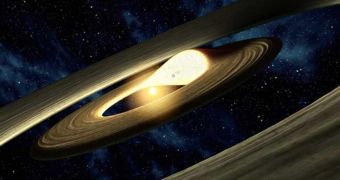When new stars are born, not all material in their precursors gets ignited and consumed. The remains usually start spinning around it, and, over millions of years, new planets are formed. The debris-filled areas around the stars are known as a protoplanetary disk. Astronomers know how long it takes for planets to form from these structures, and therefore were amazed to see that a cloud of dust and gas around the young, new star LRLL 31 was being pushed around, Space reports.
There are, in fact, two things that make the find amazing. For starters, discovering significant motions in a space structure via telescope measurements taken only five months apart is extremely rare. This usually means that the observed target is moving or otherwise evolving very fast. Secondly, a moving clump of material could only be generated by two things, experts say, either a new star forming near the first one, or a new exoplanet forming from that clump. If the latter turns out to be true, then these are the first, real-time measurements of how planets form from protoplanetary disks.
“We don't know if planets have formed, or will form, but we are gaining a better understanding of the properties and dynamics of the fine dust that could either become, or indirectly shape, a planet. This is a unique, real-time glimpse into the lengthy process of building planets,” Space Telescope Science Institute expert James Muzerolle explains the results of the finds. LRLL 31 is between two and three million years old, and is located some 1,000 light-years away, in the constellation Perseus. It was observed via the American space agency's Spitzer Space Telescope.
“A companion in the gap of an almost edge-on disk would periodically change the height of the inner disk rim as it circles around the star: a higher rim would emit more light at shorter wavelengths because it is larger and hot, but at the same time, the high rim would shadow the cool material of the outer disk, causing a decrease in the longer-wavelength light. A low rim would do the opposite. This is exactly what we observe in our data,” NASA Jet Propulsion Laboratory (JPL) expert Elise Furlan, also a co-author of a new study detailing the finds, says.

 14 DAY TRIAL //
14 DAY TRIAL //